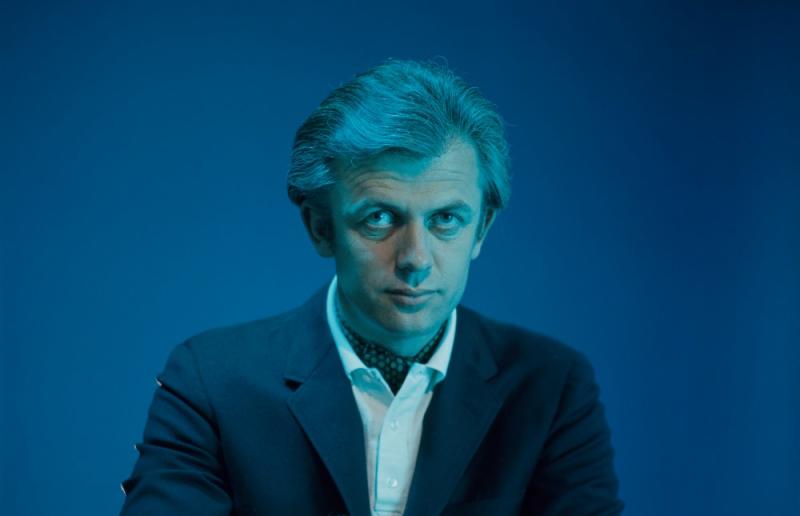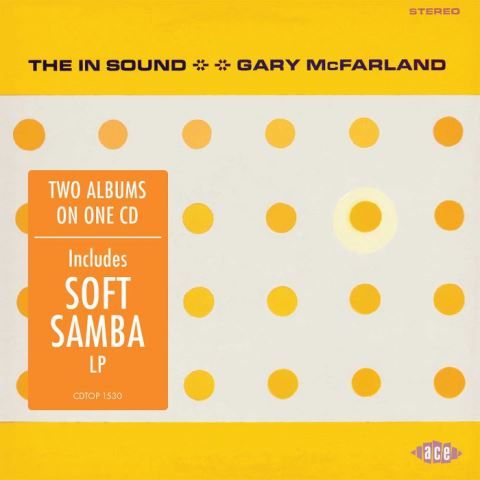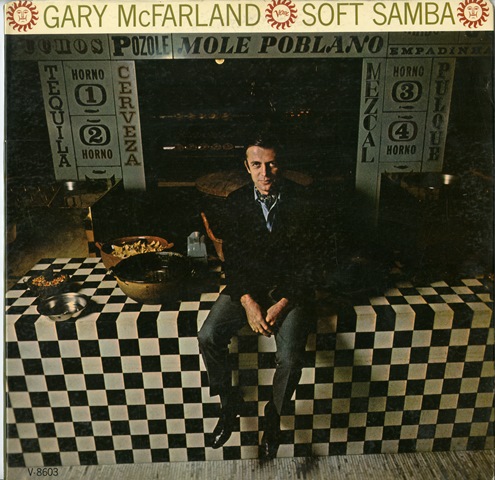Reissue CDs Weekly: Gary McFarland | reviews, news & interviews
Reissue CDs Weekly: Gary McFarland
Reissue CDs Weekly: Gary McFarland
The return of ‘Soft Samba’ and ‘The In Sound’, two of the jazz individualist's best albums

Although Gary McFarland’s 1965 album The In Sound had the Samba and Bossa Nova influences which were colouring the sound of American jazzers from around 1962, it was on the button for the year it was released.
The In Sound’s sensitivity to a then-current zeitgeist is confirmed by its fast-on-the-uptake version of “(I Can't Get No) Satisfaction”, which The Rolling Stones released as a US single on 6 June 1965 – the album was recorded at two sessions on 2 and 31 August 1965, soon after the Stones’ single hit the charts. Furthermore, Gabor Szabo’s free-form guitar solo on the album’s “Wine And Bread” has a kinship with the John Coltrane-inspired work on The Byrds’ “Eight Miles High”, the first version of which was recorded in December 1965; the same month as the release of The In Sound. And overall, the album’s deconstructed rhythms and fractured instrumental interplay suggest an au courant avant-gardist mind-set.
 McFarland was moving fast, soaking up contemporary influences and fusing them with his own sensibility of how jazz could be reconfigured for the period after The Beatles relandscaped popular music. Before The In Sound, he had already telegraphed where he was at with Soft Samba, which was issued in February 1965. It was recorded at sessions in June, September and October 1964 and opened with a track titled “Ringo, Won’t You Marry Me”. Of the album’s 11 other offerings, four were covers of Beatles’ songs.
McFarland was moving fast, soaking up contemporary influences and fusing them with his own sensibility of how jazz could be reconfigured for the period after The Beatles relandscaped popular music. Before The In Sound, he had already telegraphed where he was at with Soft Samba, which was issued in February 1965. It was recorded at sessions in June, September and October 1964 and opened with a track titled “Ringo, Won’t You Marry Me”. Of the album’s 11 other offerings, four were covers of Beatles’ songs.
According the liner notes of the new two-albums-on-one-disc reissue of The In Sound & Soft Samba, McFarland had said “the jazz business is confining” in the run-up to the release of Soft Samba. The jazz bible Down Beat unwittingly confirmed his view when it reviewed Soft Samba as “cheap and trivial…musical self-pollution.” In Britain, Melody Maker declared it “the least memorable album of the year.” Having Antônio Carlos Jobim on guitar and Willie Bobo on percussion was of no matter.
Fifty-plus years on from when they were originally released, Soft Samba and The In Sound do not sound trivial and certainly are memorable. The latter sounds timeless – it is the album on which McFarland unequivocally embraced his own muse: one looking beyond genre constraints to fashion music as pop as it was jazz. Elsewhere, the liner notes ponder his possible impact on the bands The Free Design and Love. This is moot as it’s more likely both outfits drew from the same inspirational well as McFarland. However, and much later, McFarland definitely had an effect on Stereolab: they released an EP in 1999 which borrowed The In Sound’s title and cover image.
 The In Sound has the edge on Soft Samba as it’s the more idiosyncratic album. It feels as if McFarland was aware of how far he had moved beyond where he was bracketed. The version of the 1940’s novelty song “Bloop Bleep” has an arch, borderline flat vocal which is close to being out of tune. The instrumental arrangements and line-up are familiar from American takes on Samba and Bossa Nova, but the rhythms have replaced by a metronomic repetitiveness. Throughout the album, McFarland allows his vibes to take a back seat to the guitars: Gabor Szabo’s fluid, proto-psychedelic soloing and Kenny Burrell’s see-sawing, staccato two-chord pulse. The effect is hypnotic.
The In Sound has the edge on Soft Samba as it’s the more idiosyncratic album. It feels as if McFarland was aware of how far he had moved beyond where he was bracketed. The version of the 1940’s novelty song “Bloop Bleep” has an arch, borderline flat vocal which is close to being out of tune. The instrumental arrangements and line-up are familiar from American takes on Samba and Bossa Nova, but the rhythms have replaced by a metronomic repetitiveness. Throughout the album, McFarland allows his vibes to take a back seat to the guitars: Gabor Szabo’s fluid, proto-psychedelic soloing and Kenny Burrell’s see-sawing, staccato two-chord pulse. The effect is hypnotic.
Retrospect brings context to both albums. McFarland was born in 1933 and became interested in jazz in the late 1940s. He began playing the vibes in 1955, joined his first band in 1957 after which he studied music. Despite his early compositions being performed by The Modern Jazz Quartet and Gerry Mulligan, his first credits on record were as an arranger rather than as a performer. In 1962, he scored Stan Getz’s Big Band Bossa Nova album and recorded with Anita O’Day. His first album with a sole credit arrived in 1963. Five years later, he became one of the founders of the fascinating, multi-genre label Skye which in 1969 issued his extraordinary jazz-soul concept albums America The Beautiful and Slaves. Soft Samba and The In Sound were recorded by a musical polymath who was always pushing forward.
McFarland died in November 1971 so did not live to see that his musical trajectory could be assessed as a linear, albeit unconventional, journey. The wonderful The In Sound is the perfect entry point into his unique world.
- Next Week: A Kaleidoscope of Sounds – box set of seven-inch reissues of British freakbeat and psychedelic gems
Explore topics
Share this article
The future of Arts Journalism
You can stop theartsdesk.com closing!
We urgently need financing to survive. Our fundraising drive has thus far raised £49,000 but we need to reach £100,000 or we will be forced to close. Please contribute here: https://gofund.me/c3f6033d
And if you can forward this information to anyone who might assist, we’d be grateful.

Subscribe to theartsdesk.com
Thank you for continuing to read our work on theartsdesk.com. For unlimited access to every article in its entirety, including our archive of more than 15,000 pieces, we're asking for £5 per month or £40 per year. We feel it's a very good deal, and hope you do too.
To take a subscription now simply click here.
And if you're looking for that extra gift for a friend or family member, why not treat them to a theartsdesk.com gift subscription?
more New music
 Soulwax’s 'All Systems Are Lying' lays down some tasty yet gritty electro-pop
Belgian dancefloor veterans return to the fray with a dark, pop-orientated sound
Soulwax’s 'All Systems Are Lying' lays down some tasty yet gritty electro-pop
Belgian dancefloor veterans return to the fray with a dark, pop-orientated sound
 Music Reissues Weekly: Marc and the Mambas - Three Black Nights Of Little Black Bites
When Marc Almond took time out from Soft Cell
Music Reissues Weekly: Marc and the Mambas - Three Black Nights Of Little Black Bites
When Marc Almond took time out from Soft Cell
 Album: Mobb Deep - Infinite
A solid tribute to a legendary history
Album: Mobb Deep - Infinite
A solid tribute to a legendary history
 Album: Boz Scaggs - Detour
Smooth and soulful standards from an old pro
Album: Boz Scaggs - Detour
Smooth and soulful standards from an old pro
 Emily A. Sprague realises a Japanese dream on 'Cloud Time'
A set of live improvisations that drift in and out of real beauty
Emily A. Sprague realises a Japanese dream on 'Cloud Time'
A set of live improvisations that drift in and out of real beauty
 Trio Da Kali, Milton Court review - Mali masters make the ancient new
Three supreme musicians from Bamako in transcendent mood
Trio Da Kali, Milton Court review - Mali masters make the ancient new
Three supreme musicians from Bamako in transcendent mood
 Hollie Cook's 'Shy Girl' isn't heavyweight but has a summery reggae lilt
Tropical-tinted downtempo pop that's likeable if uneventful
Hollie Cook's 'Shy Girl' isn't heavyweight but has a summery reggae lilt
Tropical-tinted downtempo pop that's likeable if uneventful
 Pop Will Eat Itself's 'Delete Everything' is noisy but patchy
Despite unlovely production, the Eighties/Nineties unit retain rowdy ebullience
Pop Will Eat Itself's 'Delete Everything' is noisy but patchy
Despite unlovely production, the Eighties/Nineties unit retain rowdy ebullience
 Music Reissues Weekly: The Earlies - These Were The Earlies
Lancashire and Texas unite to fashion a 2004 landmark of modern psychedelia
Music Reissues Weekly: The Earlies - These Were The Earlies
Lancashire and Texas unite to fashion a 2004 landmark of modern psychedelia
 Odd times and clunking lines in 'The Life of a Showgirl' for Taylor Swift
A record this weird should be more interesting, surely
Odd times and clunking lines in 'The Life of a Showgirl' for Taylor Swift
A record this weird should be more interesting, surely
 Waylon Jennings' 'Songbird' raises this country great from the grave
The first of a trove of posthumous recordings from the 1970s and early 1980s
Waylon Jennings' 'Songbird' raises this country great from the grave
The first of a trove of posthumous recordings from the 1970s and early 1980s

Add comment